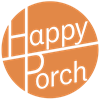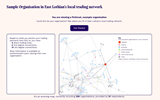Community Cred: Mutual Credit meets Circularity
Here at HappyPorch, it goes without saying that we are passionate about the role that digital technology plays in the effective transition to more circular economies. Technology, to us, is a tool that can be shaped so as to create a significant positive impact in the world. Given that, we’re pleased to have recently put our software engineering and design skills to use in service of supporting a project that is exploring the possibilities at the intersection of mutual credit systems and the circular economy.
Known as CommunityCred, it’s part of something Dr. Juli Huang, Senior Lecturer in Anthropology of Development at University of Edinburgh, Mary Michel from Ostrero, and others have been thinking about and researching, for some years now.
But first, what is a mutual credit system, as it relates to circularity? This graphic, created by Juli, neatly explains it.
Mutual credit systems are not a new thing. They go back millenia, in modern times they are perhaps most famously exemplified by Sardex, itself a reaction to the 2008 global financial crisis.
When ecologically additive behaviours by individuals, organisations and businesses are incentivised, two things happen: the ecological/resource use aspect of course. But it also frees up capital resources and thus invigorates the local economy and community in the process. A knock on effect we see is the social impact - a knitting together of people when they collectively engage in these activities, and see the resulting benefit from doing so.
Likewise, in our view, there are several intersections between mutual credit and the Circular Economy. As Walter Stahel, an early advocate for circularity saw it, a successful circular economy may actually be better described as a plural. In other words, local economies using resources and skills in ways that are both resource efficient, and also beneficial for local people and ecosystems. Stahel also believed that a core aspect of circularity is re-examining the way we view value, and the way that value is implemented, i.e. the movement of money.
One of the aims of the CommunityCred project is to incorporate circular economy activities in the mix of what counts towards accruing credits, in addition to what are normally paid transactions with a business. What that entails, and how it’s included in such a system is the subject of continued discussion and research.
However, they are finding a distinct connection between the two, that mutual credit systems can act as circular economy enablers in a variety of ways: When a mutual credit system keeps wealth circulating locally, it also strengthens reuse networks. As it mobilises underused assets and skills, it reduces the need for new resources. Such a system also incentivises circular practices such as repair services and resource sharing.
Beyond that, how do you make something that perhaps feels intangible and amorphous, relatable and actionable to the broader public? How do you survey and collect data on the current and future potential interactions on a specific geography? That’s in part why we were brought in, as part of Juli and her team’s ongoing research in this matter.
The idea came to literally visualise the network of people, organisations and enterprises that comprise the local community, how they could interact in such a system, and the resulting financial impact and opportunities for reuse resources to flow. And in doing so, the visualisation and the resulting engagement it activated could meaningfully enhance the research project.
How so? In many ways, it could act as critical groundwork to reveal currently invisible circular flows, for example who trades with whom, and what resources move where. It could also illuminate opportunities for circularity, such as spotting currently short supply chains or underused capacity. And fundamentally, it could provide baseline evidence to test if a mutual credit system could work in this region.
Thus, we created a tool to map such a network, where you can see where and how you are linked to the broader community. It is (we hope) a fun, simple, and relatable way to engage with, view and add to that research. But deeper than that, it’s an essential vehicle to effectively design a mutual credit system.
The CommunityCred website represents a first step towards realising such a system in the world. Inviting organisations in East Lothian to add their data to the initial map we created will help fill in the picture of what’s possible, gauge interest, and determine the overall viability of a mutual credit concept and its contribution to the development of Scotland’s Circular Economy. As of this writing, currently the map includes 263 local organisations with 322 regular local transactions worth around £469,669 every year.
Beyond the raw numbers, what benefit does this translate to?
Mutual credit systems boost financial resilience, preserving cash reserves. They expand market opportunities, thus mobilizing spare capacity, materials, assets and skills. And perhaps most impactfully, they prevent money from leaking out of the local economy, keeping spending power within the area.
What happens from here?
The site is now being shared with the communities that comprise the East Lothian region, near Edinburgh. The hope is that with their feedback, input, and adding to the map, Dr. Juli, Mary & the team will then be able to demonstrate interest in such a system, and therefore move from the theoretical to the actual, creating a living, circular infused mutual credit system, replicable in other parts of the country.
Something we would heartily support coming to pass.




About the author
Paul Smith
Paul is a self-described communications Swiss Army Knife, having spent the majority of his career supporting beneficially impactful companies across the spectrum effectively tell their story to the world. The circular economy is a long time love of his, so he’s thrilled to now play a part in expanding its impact in the world. When not behind the computer, Paul can usually be found behind a book, on his bike exploring, or out for a walk in the forests of Fontainebleau, getting a closer look at the latest moss…